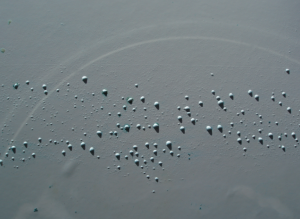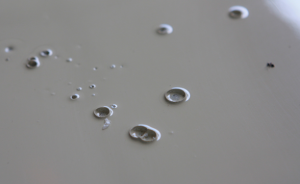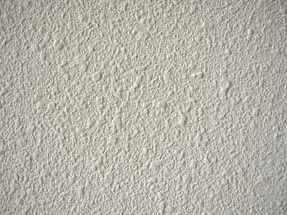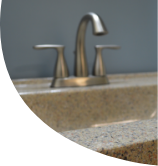4 Common Problems with Bathtub Refinishing and Their Solutions
Successfully resurfaced bathtubs are nearly impossible to discern over brand new tubs. And resurfacing can save you hundreds, if not thousands, on your bathroom remodel. But it is important to know, not every job turns out perfectly because not every bathtub refinishing professional is experienced.
Keep an eye out for these imperfections in your finish…
Bubbles

If air becomes trapped in between individual layers of coating, bubbles can appear. This is sometimes due to the coating not curing properly, but it could also happen if the refinisher does not strip the tubs’ old finish prior to resurfacing. A bathtub will only need stripped if it has been previously resurfaced, even with a DIY kit. Some signs that you bathtub has been resurfaced before include peeling, chipping, or flaking especially around the drain or soap dish area. It is important to completely remove, or strip, the old finish off of the tub so the new surface can bond to the original substrate. Failure to strip a previously resurfaced tub can result in bubbles in the finish or eventually premature coating failure. And stripping your tub can be dangerous business due to the hazardous chemicals often found in stripping agents. Ask your refinisher if any of their products contain methylene chloride before making a hiring decision.
Solution: Make sure your resurfacing technician strips the tub if it has been done before. Or wait 24 hrs for the coating the cure properly and do not let water come in contact with the tub during the curing process.
Fading
Fading can occur if the refinish coating is mixed too thinly, or just an incorrect mixture of materials. It is also caused by not allowing proper curing time or using improper cleaners. If the coating was mixed too thinly before application then some of the original surface will show through, hence the fading. In other cases where abrasive cleaners are used, such as Comet or Ajax, the tub fades because the cleaners are sanding down the finish. The gloss is usually the first to go, but if there is a continued use of abrasive cleaners then fading is also a possibility. Harsh abrasive chemicals are not to be used on refinished tubs.
Solution: Choose a company who uses superior products and that have been trained how to accurately mix the material, and who also take the time to educate you on the proper ways to care for your surface. Or ask your refinishing professional for literature on how to properly maintain your new surface for years to come. Additionally, their office staff or website may be able to offer some insight on their recommended practices.
Rough Texture

A refinished bathtub should feel smooth to the touch. But if your refinished bathtub has a texture that feels rough, pointy, or like sandpaper (and you didn’t have a non-slip surface applied) this could indicate that the surface wasn’t sanded or cleaned properly before the coating was applied. It could also be that dust and debris got trapped in the finish. Because it is impossible to ensure a dust-free environment in the bathroom in some cases dust particles settle in the finish during curing. Some slight imperfections are normal but too much can be uncomfortable. Give your refinishing professional a call if your tubs coating is uncomfortably rough, in most cases this issue will fall under warranty and can be repaired in a short amount of time.

Solution: The refinishing process is not dust free to make sure the refinishing technician sands the tub down and cleans the tub multiple times during the process. Try cleaning the tub with a product from their recommended cleaners list, sometimes the dust will rinse off the tub with no need for a return visit.
Sticky or Tacky Feel

If the newly refinished bathtub feels sticky or tacky after the required cure period, avoid using the tub. The sticky feeling indicates that the coating did not cure properly and may need to be resprayed. This can occur if the resurfacing materials aren’t mixed properly or the coating is reacting to a cleaning agent or chemical. This is not a common occurrence if the refinishing professional is adequately trained on the proper mixing ratios for the materials. However, if it does occur the best policy is to keep your hands off the tub.
Solution: Contact the company who preformed the work if the coating is still sticky/tacky after two days. If the company has a warranty on the workmanship then this issue should fall under it. Also, it may be useful to check humidity levels because that can effect curing time as well as extremely cold weather.
One response to “4 Common Problems with Bathtub Refinishing and Their Solutions”
Leave a Reply
You must be logged in to post a comment.



Can a bathtub be refinished several times. Our’s has been reglazed one time and it peeled off after about 10 years.